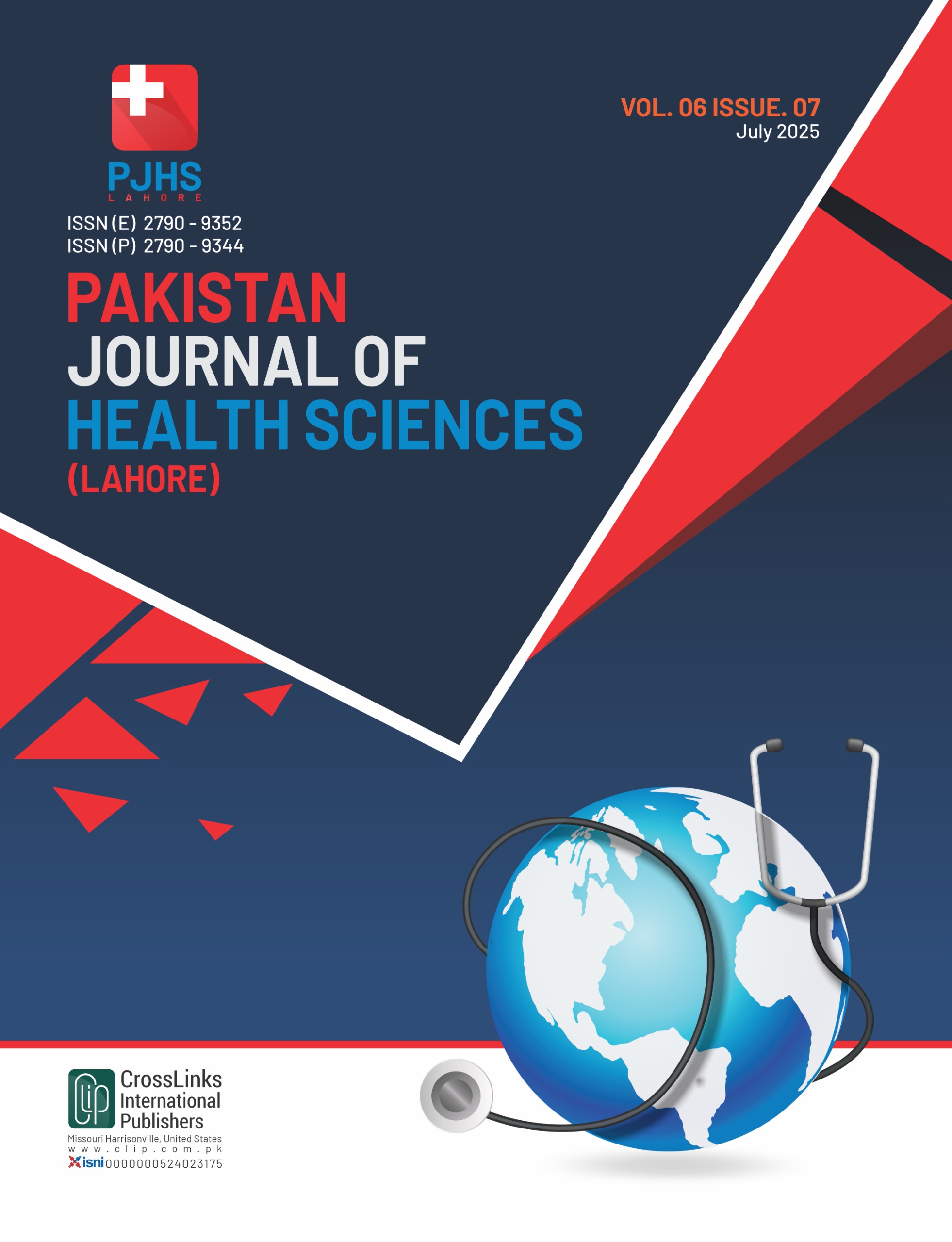Prevalence and Associated Factors of Obesity in Children Aged 2-11 Years at a Tertiary Care Hospital in Islamabad
Prevalence and Associated Factors of Obesity in Children Aged 2-11 Years
DOI:
https://doi.org/10.54393/pjhs.v6i7.3112Keywords:
Children, Obesity, Prevalence, Physical ActivityAbstract
Childhood obesity is a rising health concern globally, with an increasing trend in many low middle-income countries like Pakistan, due to rapid urbanization and lifestyle changes like unhealthy dietary practices and lack of physical activity. Objectives: To find out the prevalence of obesity and some associated variables, such as demographic, socioeconomic, and lifestyle factors, among the children aged 2 to 11 years visiting a tertiary care hospital in Islamabad, Pakistan. Methods: The study was conducted from May 10, 2024, to November 10, 2024, at the Pediatric Department of the Avicenna Medical Complex in Islamabad. 220 children aged 2-11 years were recruited using consecutive sampling. Obesity was defined as a BMI ≥ +2SD on WHO percentile charts, and data related to its associated factors were collected. SPSS version 26.0 was used to analyze data and report descriptive statistics; chi-square tests were performed to determine statistical significance. Results: The prevalence of obesity was 7% (n=15). Among participants, 57% were aged 2-6 years, 59% were male, and 63% resided in rural areas. An insignificant association was found between obesity and age, gender, socioeconomic status, or family history (p>0.05). A higher obesity trend was observed in urban areas (11%) than rural areas (4%), though it was statistically insignificant (p=0.0538). Most of the children were physically active (88%), with high obesity (54%) reported in inactive children. Conclusions: Childhood obesity was low, with no significant associations found with key demographic or socioeconomic factors. However, urban residence and physical inactivity showed trends toward higher obesity risk.
References
Murray CJ, Aravkin AY, Zheng P, Abbafati C, Abbas KM, Abbasi-Kangevari M et al. Global Burden of 87 Risk Factors in 204 Countries and Territories, 1990–2019: A Systematic Analysis for the Global Burden of Disease Study 2019. The Lancet. 2020 Oct; 396(10258): 1223-49.
Abarca-Gómez L, Abdeen ZA, Hamid ZA, Abu-Rmeileh NM, Acosta-Cazares B, Acuin C et al. Worldwide Trends in Body-Mass Index, Underweight, Overweight, and Obesity from 1975 to 2016: A Pooled Analysis of 2416 Population-Based Measurement Studies in 128· 9 Million Children, Adolescents, and Adults. The Lancet. 2017 Dec; 390(10113): 2627-42.
Popkin BM and Ng SW. The Nutrition Transition to A Stage of High Obesity and Non-Communicable Disease Prevalence Dominated by Ultra‐Processed Foods Is Not Inevitable. Obesity Reviews. 2022 Jan; 23(1): e13366. doi: 10.1111/obr.13366.
Lobstein T, Jackson-Leach R, Moodie ML, Hall KD, Gortmaker SL, Swinburn BA et al. Child and Adolescent Obesity: Part of A Bigger Picture. The Lancet. 2015 Jun; 385(9986): 2510-20. doi: 10.1016/S0140-6736(14)61746-3.
Roth CL and Jain V. Rising Obesity in Children: A Serious Public Health Concern. The Indian Journal of Pediatrics. 2018 Jun; 85(6): 461-2. doi: 10.1007/s12098-018-2639-7.
Kumar S and Kelly AS. Review of Childhood Obesity: From Epidemiology, Etiology, and Comorbidities to Clinical Assessment and Treatment. In Mayo Clinic Proceedings. 2017 Feb; 92(2): 251-265. doi: 10.1016/j.mayocp.2016.09.017.
Tanveer M, Hohmann A, Roy N, Zeba A, Tanveer U, Siener M. The Current Prevalence of Underweight, Overweight, and Obesity Associated with Demographic Factors Among Pakistan School-Aged Children and Adolescents—An Empirical Cross-Sectional Study. International Journal of Environmental Research and Public Health. 2022 Sep 15;19(18):11619. doi: 10.3390/ijerph191811619.
Ekanayake HD, Salibi G, Tzenios N. Analysis of Association Between Childhood Overweight/Obesity with Screen Time, Sedentary Life Style and Low Levels of Physical Activity. Special Journal of the Medical Academy and other Life Sciences. 2023 Jul; 1(6). doi: 10.58676/sjmas.v1i6.40.
Fang K, Mu M, Liu K, He Y. Screen Time and Childhood Overweight/Obesity: A Systematic Review and Meta‐Analysis. Child: Care, Health and Development. 2019 Sep; 45(5): 744-53. doi: 10.1111/cch.12701.
Akbar Z, Naeem S, Javed S, Akhtar Z, Ashfaq Z, Ismail WU et al. Risk Factors of Overweight and Obesity in Childhood and Adolescence in Pakistan, A Systematic Review. Discover Public Health. 2025 Mar; 22(1): 75. doi: 10.1186/s12982-025-00465-1.
Jadhav OP and Choure V. Understanding and Addressing Childhood Obesity: A Comprehensive Review. International Journal of Academic Medicine and Pharmacy. 2024; 6(3): 558-64.
Tanveer M, Cai Y, Badicu G, Asghar E, Batrakoulis A, Ardigò LP, Brand S. Associations of 24‐h movement behaviour with overweight and obesity among school‐aged children and adolescents in Pakistan: An empirical cross‐sectional study. Pediatric Obesity. 2025 May; 20(5): e13208. doi: 10.1111/ijpo.13208.
Asoba GN, Ebong FS, Metuge S, Tabe EK, Ning TR, Ngole SI. The Effects of Different Feeding Practices on the Nutritional Status of Infants below 12 Months Old in the Kumba 1 Sub-Division. Food and Nutrition Sciences. 2024 May; 15(5): 336-50. doi: 10.4236/fns.2024.155022.
Borghi E and Sachdev HS. Should A Single Growth Standard Be Used to Judge the Nutritional Status of Children Under Age 5 Years Globally: Yes. The American Journal of Clinical Nutrition. 2024 Oct; 120(4): 764-8. doi: 10.1016/j.ajcnut.2024.04.019.
Sahoo K, Sahoo B, Choudhury AK, Sofi NY, Kumar R, Bhadoria AS. Childhood Obesity: Causes and Consequences. Journal of Family Medicine and Primary Care. 2015 Apr; 4(2): 187-92. doi: 10.4103/2249-4863.154628.
Wang T, Akram S, Hassan MU, Khurram F, Shahzad MF. The Role of Child Development and Socioeconomic Factors in Child Obesity in Pakistan. Acta Psychologica. 2025 May; 255: 104966. doi: 10.1016/j.actpsy.2025.104966.
Janssen I and LeBlanc AG. Systematic Review of the Health Benefits of Physical Activity and Fitness in School-Aged Children and Youth. International Journal of Behavioral Nutrition and Physical Activity. 2010 May; 7(1): 40. doi: 10.1186/1479-5868-7-40.
Bakour C, Mansuri F, Johns-Rejano C, Crozier M, Wilson R, Sappenfield W. Association Between Screen Time and Obesity in US Adolescents: A Cross-Sectional Analysis Using National Survey of Children’s Health 2016–2017. PLOS One. 2022 Dec; 17(12): e0278490. doi: 10.1371/journal.pone.0278490.
Haghjoo P, Siri G, Soleimani E, Farhangi MA, Alesaeidi S. Screen Time Increases Overweight and Obesity Risk among Adolescents: A Systematic Review and Dose-Response Meta-Analysis. BioMed Central Primary Care. 2022 Jun; 23(1): 161. doi: 10.1186/s12875-022-01761-4.
Ramírez-Coronel AA, Abdu WJ, Alshahrani SH, Treve M, Jalil AT, Alkhayyat AS et al. Retracted Article: Childhood Obesity Risk Increases with Increased Screen Time: A Systematic Review and Dose–Response Meta-Analysis. Journal of Health, Population and Nutrition. 2023 Jan; 42(1): 5. doi: 10.1186/s41043-022-00344-4.
Rai VR. Confronting the Obesity Epidemic in Pakistani Children-Management, Causes, and the Role of Monogenic Factors. Journal of the College of Physicians and Surgeons--Pakistan. 2024 Dec; 34(12): 1549-50. doi: 10.29271/jcpsp.2024.12.1549.
Tanveer M, Asghar E, Badicu G, Roy N, Siener M, Tanveer U et al. Association of Physical Activity and Physical Education with Overweight and Obesity among School‐Aged Children and Adolescents in Pakistan: An Empirical Cross‐Sectional Study. Advances in Public Health. 2024; 2024(1): 5095049. doi: 10.1155/2024/5095049.
Hudaib M, Hussain L, Nazim L, Mohi Uddin S, Jamil MU, Bham SQ et al. Understanding Childhood Obesity in Pakistan: Exploring the Knowledge, Attitudes, Practices of Mothers, and Influential Factors. A Cross-Sectional Study. Frontiers in Public Health. 2024 Nov; 12: 1475455. doi: 10.3389/fpubh.2024.1475455.
Downloads
Published
How to Cite
Issue
Section
License
Copyright (c) 2025 Pakistan Journal of Health Sciences

This work is licensed under a Creative Commons Attribution 4.0 International License.
This is an open-access journal and all the published articles / items are distributed under the terms of the Creative Commons Attribution License, which permits unrestricted use, distribution, and reproduction in any medium, provided the original author and source are credited. For comments













